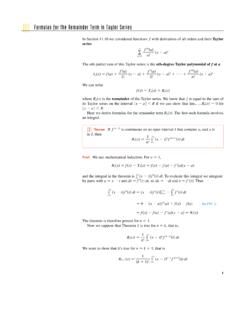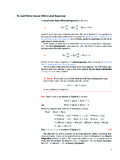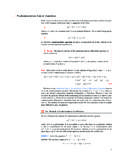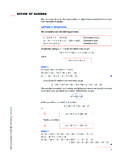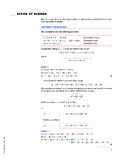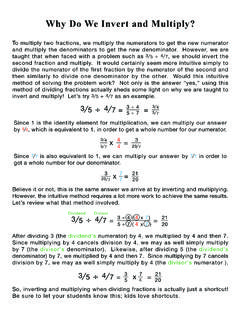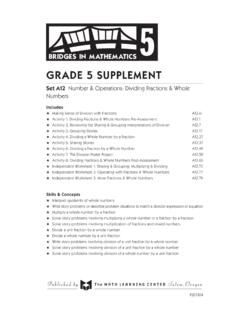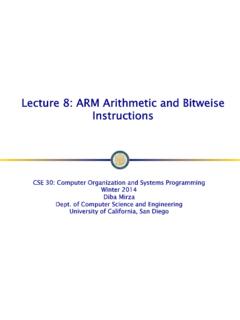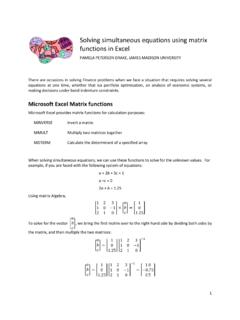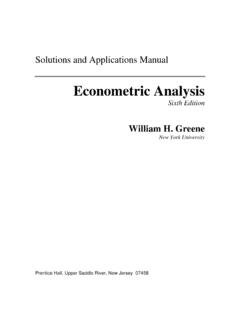Transcription of REVIEW OF ALGEBRA - Stewart Calculus
1 REVIEW OF ALGEBRAHere we REVIEW the basic rules and procedures of ALGEBRA that you need to know in orderto be successful in OPERATIONSThe real numbers have the following properties:(Commutative Law)(Associative Law)(Distributive law)In particular, putting in the Distributive Law, we getand soEXAMPLE 1(a)(b)(c)If we use the Distributive Law three times, we getThis says that we multiply two factors by multiplying each term in one factor by each termin the other factor and adding the products. Schematically, we haveIn the case where and , we haveor Similarly, we obtainEXAMPLE 2(a)(b)(c) 12x2 5x 21 12x2 3x 9 2x 123 x 1 4x 3 2 x 6 3 4x2 x 3 2x 12 x 6 2 x2 12x 36 2x 1 3x 5 6x2 3x 10x 5 6x2 7x 5 a b 2 a2 2ab b22 a b 2 a2 2ab b21 a b 2 a2 ba ab b2d bc a a b c d a b c d a b c a b d ac bc ad bd4 3 x 2 4 3x 6 10 3x2t 7x 2tx 11 14tx 4t2x 22t 3xy 4x 3 4 x2y 12x2y b c b c b c 1 b c 1 b 1 ca 1a b c ab ac ab c a bc a b c a b c ab baa b b a1 Stewart : Calculus ,Sixth Edition.
2 ISBN: 0495011606. 2008 Brooks/Cole. All rights add two fractions with the same denominator, we use the Distributive Law:Thus, it is true thatBut remember to avoid the following common error:|(For instance, take to see the error.)To add two fractions with different denominators, we use a common denominator:We multiply such fractions as follows:In particular, it is true thatTo divide two fractions, we invert and multiply :EXAMPLE 3(a)(b)(c)s2tu ut 2 s2t2u 2u s2t22 x2 2x 6x2 x 23x 1 xx 2 3 x 2 x x 1 x 1 x 2 3x 6 x2 xx2 x 2x 3x xx 3x 1 3xabcd ab dc adbc ab ab a bab cd acbdab cd ad bcbda b c 1ab c ab aca cb ab cbab cb 1b a 1b c 1b a c a cb2 REVIEW OF ALGEBRAS tewart: Calculus ,Sixth Edition. ISBN: 0495011606. 2008 Brooks/Cole. All rights reserved.(d)FACTORINGWe have used the Distributive Law to expand certain algebraic expressions.
3 We sometimesneed to reverse this process (again using the Distributive Law) by factoring an expressionas a product of simpler ones. The easiest situation occurs when the expression has a com-mon factor as follows:To factor a quadratic of the form we note thatso we need to choose numbers so that and .EXAMPLE 4 Factor .SOLUTIONThe two integers that add to give and multiply to give are and .ThereforeEXAMPLE 5 Factor .SOLUTIONEven though the coefficient of is not , we can still look for factors of theform and , where . Experimentation reveals thatSome special quadratics can be factored by using Equations 1 or 2 (from right to left)or by using the formula for a difference of squares:The analogous formula for a difference of cubes iswhich you can verify by expanding the right side.
4 For a sum of cubes we haveEXAMPLE 6(a)(Equation 2; )(b)(Equation 3; )(c)(Equation 5; )a x, b 2x3 8 x 2 x2 2x 4 a 2x, b 54x2 25 2x 5 2x 5 a x, b 3x2 6x 9 x 3 2a3 b3 a b a2 ab b2 5a3 b3 a b a2 ab b2 4a2 b2 a b a b 32x2 7x 4 2x 1 x 4 rs 4x s2x r1x22x2 7x 4x2 5x 24 x 3 x 8 8 3 245x2 5x 24rs cr s br and s x r x s x2 r s x rsx2 bx c3x(x-2)=3x@-6xExpandingFactoringxy 11 yx x yyx yx x yy xx y x x y y x y x2 xyxy y2 REVIEW OF ALGEBRA 3 Stewart : Calculus ,Sixth Edition. ISBN: 0495011606. 2008 Brooks/Cole. All rights 7 Simplify .SOLUTIONF actoring numerator and denominator, we haveTo factor polynomials of degree 3 or more, we sometimes use the following Factor TheoremIf is a polynomial and , then is a 8 Factor .SOLUTIONLet . If , where is an integer, then isa factor of 24.
5 Thus, the possibilities for are and .We find that ,,. By the Factor Theorem,is afactor. Instead of substituting further, we use long division as follows:ThereforeCOMPLETING THE SQUAREC ompleting the square is a useful technique for graphing parabolas or integrating rationalfunctions. Completing the square means rewriting a quadratic in the form and can be accomplished the number from the terms involving . and subtracting the square of half the coefficient of .In general, we haveEXAMPLE 9 Rewrite by completing the square of half the coefficient of is . Thusx2 x 1 x2 x 14 14 1 (x 12)2 3414xx2 x 1 a x b2a 2 c b24a a x2 ba x b2a 2 b2a 2 cax2 bx c a x2 ba x cxxaa x p 2 qax2 bx c x 2 x 3 x 4 x3 3x2 10x 24 x 2 x2 x 12 12x 24 12x 24 x2 2x x2 10xx3 2x2 x 2 x3 3x2 10x 24 12xx2 x 2P 2 0P 1 30P 1 12 24 1, 2, 3, 4, 6, 8, 12,bbbP b 0P x x3 3x2 10x 24x3 3x2 10x 24P x x bP b 0P6x2 16x2 2x 8 x 4 x 4 x 4 x 2 x 4x 2x2 16x2 2x 84 REVIEW OF ALGEBRAS tewart: Calculus ,Sixth Edition.
6 ISBN: 0495011606. 2008 Brooks/Cole. All rights 10 QUADRATIC FORMULABy completing the square as above we can obtain the following formula for the roots of aquadratic Quadratic FormulaThe roots of the quadratic equation areEXAMPLE 11 Solve the equation .SOLUTIONWith ,,, the quadratic formula gives the solutionsThe quantity that appears in the quadratic formula is called the are three , the equation has two real , the roots are , the equation has no real root. (The roots are complex.)These three cases correspond to the fact that the number of times the parabolacrosses the -axis is 2, 1, or 0 (see Figure 1). In case (3) the quadraticcan t be factored and is called 12 The quadratic is irreducible because its discriminant is negative:Therefore, it is impossible to factor .x2 x 2b2 4ac 12 4 1 2 7 0x2 x 2xy0xy0xy0(a)b@-4ac>0(b)b@-4ac=0(c)b@-4a c<0 FIGURE 1 Possible graphs of y=ax@+bx+cax2 bx cxy ax2 bx cb2 4ac 0b2 4ac 0b2 4ac 0b2 4acx 3 s32 4 5 3 2 5 3 s6910c 3b 3a 55x2 3x 3 0x b sb2 4ac2aax2 bx c 07 2 x 3 2 9 11 2 x 3 2 72x2 12x 11 2 x2 6x 11 2 x2 6x 9 9 11 REVIEW OF ALGEBRA 5 Stewart : Calculus ,Sixth Edition.
7 ISBN: 0495011606. 2008 Brooks/Cole. All rights BINOMIAL THEOREMR ecall the binomial expression from Equation 1:If we multiply both sides by and simplify, we get the binomial expansionRepeating this procedure, we getIn general, we have the following Binomial TheoremIf is a positive integer, thenEXAMPLE 13 Expand .SOLUTIONU sing the Binomial Theorem with ,,, we haveRADICALSThe most commonly occurring radicals are square roots. The symbol means the posi-tive square root of. ThusmeansandSince , the symbol makes sense only when . Here are two rules forworking with square roots:However, there is no similar rule for the square root of a sum. In fact, you should remem-ber to avoid the following common error:|(For instance, take and to see the error.)b 16a 9sa b sa sb ab sasbsab sa sb10a 0saa x2 0x 0x2 ax sas1 x5 10x4 40x3 80x2 80x 32 x 2 5 x5 5x4 2 5 41 2 x3 2 2 5 4 31 2 3 x2 2 3 5x 2 4 2 5k 5b 2a x x 2 5 kabk 1 bk k k 1 k n 1 1 2 3 n ak nbn k k 1 k 2 1 2 3 ak 3b3 a b k ak kak 1b k k 1 1 2 ak 2b2k9 a b 4 a4 4a3b 6a2b2 4ab3 b4 a b 3 a3 3a2b 3ab2 b38 a b a b 2 a2 2ab b26 REVIEW OF ALGEBRAS tewart: Calculus ,Sixth Edition.
8 ISBN: 0495011606. 2008 Brooks/Cole. All rights OF ALGEBRA 7 EXAMPLE 14(a)(b)Notice that because indicates the positive square root. (See Absolute Value.)In general, if is a positive integer,meansIf is even, then and .Thus because , but and are not defined. The follow-ing rules are valid:EXAMPLE 15To rationalizea numerator or denominator that contains an expression such as, we multiply both the numerator and the denominator by the conjugate radical. Then we can take advantage of the formula for a difference of squares:EXAMPLE 16 Rationalize the numerator in the expression .SOLUTIONWe multiply the numerator and the denominator by the conjugate radical:EXPONENTSLet be any positive number and let be a positive integer.
9 Then, by definition, n snam (sna)m m is any integera1 n snaa n 1ana0 1an a a ana xx(sx 4 2) 1sx 4 2sx 4 2x sx 4 2x sx 4 2sx 4 2 x 4 4x(sx 4 2)sx 4 2sx 4 2x(sa sb)(sa sb) (sa)2 (sb)2 a bsa sbsa sbs3x4 s3x3x s3x3 s3x xs3x ab snasnbsnab sna snbs6 8s4 8 2 3 8s3 8 2x 0a 0nxn ax snans1sx2 x sx2y sx2 sy x sys18s2 182 s9 3 Stewart : Calculus ,Sixth Edition. ISBN: 0495011606. 2008 Brooks/Cole. All rights REVIEW OF ALGEBRALaws of ExponentsLet and be positive numbers and let and be any rational numbers (that is, ratios of integers). words, these five laws can be stated as multiply two powers of the same number, we add the divide two powers of the same number, we subtract the raise a power to a new power, we multiply the raise a product to a power, we raise each factor to the raise a quotient to a power, we raise both numerator and denominator to the 17(a)(b)(c)Alternative solution:(d)(e)INEQUALITIESWhen working with inequalities, note the following for , then.
10 And , then . and , then . and , then . , then .Rule 1 says that we can add any number to both sides of an inequality, and Rule 2 saysthat two inequalities can be added. However, we have to be careful with 3 says that we can multiply both sides of an inequality by a positive |number, but Rule 4 says that if we multiply both sides of an inequality by a negative num-ber, then we reverse the direction of the example, if we take the inequality 1 a 1 b0 a bac bcc 0a bac bcc 0a ba c b dc da ba c b ca b xy 3 y2xz 4 x3y3 y8x4z4 x7y5z 41s3x4 1x4 3 x 4 343 2 (s4)3 23 843 2 s43 s64 8 y x y x xy y x y xxyx 2 y 2x 1 y 1 1x2 1y21x 1y y2 x2x2y2y xxy y2 x2x2y2 xyy x28 82 28 23 2 28 26 214 ab r arbr b 0 ab r arbr ar s arsaras ar sar as ar ssrba11 Stewart : Calculus ,Sixth Edition.


